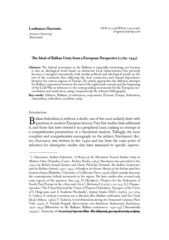Prikaz osnovnih podataka o dokumentu
The Ideal of Balkan Unity from a European Perspective (1789-1945)
| dc.creator | Hassiotis, Loukianos | |
| dc.date.accessioned | 2018-11-09T13:20:17Z | |
| dc.date.available | 2018-11-09T13:20:17Z | |
| dc.date.issued | 2010 | |
| dc.identifier.issn | 0350-7653 | |
| dc.identifier.uri | https://dais.sanu.ac.rs/123456789/4316 | |
| dc.description.abstract | The federal movement in the Balkans is especially interesting, not because it was an ideological trend based on distinctive local characteristics, but precisely because it emerged concurrently with similar political and ideological trends on the rest of the continent, thus reflecting the close connection and mutual dependence between the various regions of Europe. The article approaches the different attempts for Balkan cooperation between the end of the eighteenth century and the beginning of the Cold War in reference to the corresponding movements for the European reconciliation and unification, using comparatively the relevant bibliography. . | en |
| dc.publisher | Belgrade : Institute for Balkan Studies, Serbian Academy of Sciences and Arts | |
| dc.rights | openAccess | |
| dc.rights.uri | https://creativecommons.org/licenses/by-nc-sa/4.0/ | |
| dc.source | Balcanica | |
| dc.subject | Alliance | en |
| dc.subject | Balkans | en |
| dc.subject | Conferences | en |
| dc.subject | cooperation | en |
| dc.subject | Entente | en |
| dc.subject | Europe | en |
| dc.subject | federation | en |
| dc.subject | nationalism | en |
| dc.subject | radicalism | en |
| dc.subject | socialism | en |
| dc.subject | unity | en |
| dc.title | The Ideal of Balkan Unity from a European Perspective (1789-1945) | en |
| dc.type | article | |
| dc.rights.license | BY-NC-SA | |
| dcterms.abstract | Хассиотис Лоукианос; | |
| dc.citation.spage | 209 | |
| dc.citation.epage | 229 | |
| dc.citation.issue | XLI | |
| dc.identifier.doi | 10.2298/BALC1041209H | |
| dc.type.version | publishedVersion | en |
| dc.identifier.fulltext | https://dais.sanu.ac.rs/bitstream/id/21264/4427.pdf | |
| dc.citation.other | (41): 209-229 | |
| dc.identifier.rcub | https://hdl.handle.net/21.15107/rcub_dais_4316 |

